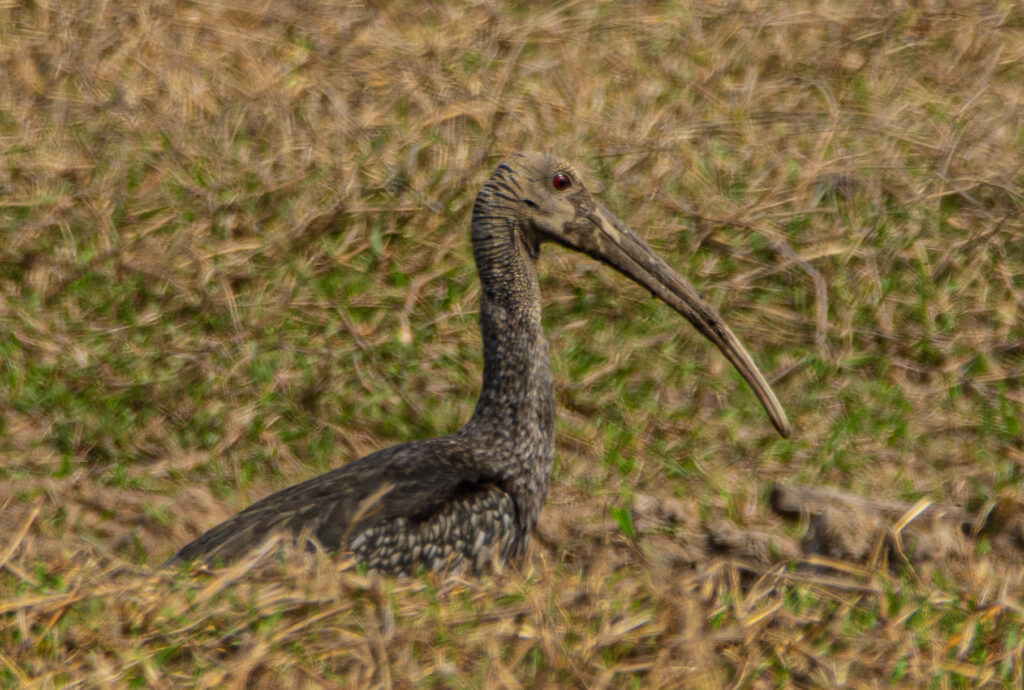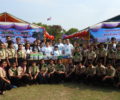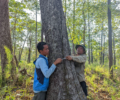Population Census Increase Underscores the Value of Lomphat as a Stronghold for the Giant Ibis.

NatureLife Cambodia, a national biodiversity conservation organization, in March 2024 completed the three-month Lomphat Wildlife Sanctuary Giant Ibis Population Census. Based in Phnom Penh, NatureLife Cambodia conducts species conservation programs at several protected areas in Cambodia. The organization was established with technical support from BirdLife International and financial support from the Critical Ecosystem Partnership Fund through International Union for Conservation of Nature (IUCN). One of these species is the Giant Ibis (Thaumatibis gigantea).
Giant Ibis is the world’s largest species of Ibis and the National Bird of Cambodia. It is now rated as Critically Endangered on the IUCN Red List, with a global population of around 194 mature birds. The Giant Ibis is found almost exclusively in Cambodia with very few recent records from Laos and Vietnam possibly only representing spill-over from the Cambodian Giant Ibis population.
Perhaps the most emblematic species of Cambodian dry forest, it lives in small family groups, and is instantly recognisable due to its size, its decorous grey plumage, and huge curved beak. Up close it can also be seen that the Giant Ibis has sparse or no feathers covering the top of its head, a hint to its preferred foraging habits, of hunting out the eels, frogs, fish and invertebrates in the forest waterholes and wetlands found in the dry forest landscape. The distinctive, and slightly haunting, cries of the Giant Ibis ring out across the forest in the early morning and evening, and are featured in many folk tales.
One priority site for Giant Ibis is Lomphat Wildlife Sanctuary, the Protected Area is large, recently expanded from around 2,500 square kilometres to now over 3000, and is composed of around 70% Dry Deciduous Forest, the primary habitat of Giant Ibis
The low population of Giant Ibis throughout South-East Asia is largely the result of loss of habitat due to the large-scale conversion of natural forest to agricultural land. Giant Ibis face a plethora of other threats where they remain in Cambodia. These include small-scale encroachment of habitat by communities and infrastructure development, persecution by hunting and poisoning, destruction of nesting trees from illegal logging, persecution of Ibis by disturbance of nests, hunting or poisoning, and competition for resources by local communities
In the Protected Areas that hold the remain breeding populations, it is essential to keep track of the populations, to understand where they are, how many there are, and what threats they are facing locally.
At Lomphat Wildlife Sanctuary (LWS), the conservation NGO NatureLife Cambodia has been monitoring Giant Ibis for over a decade, with the financial support of USAID-Morodok Baitang and the Critical Ecosystem Partnership Fund (CEPF). During this time, a survey census methodology was developed for counting Giant Ibis during the non-breeding period in dry season. This methodology was carried out in 2019 and 2022, and has just been carried out for the third Lomphat Wildlife Sanctuary Giant Ibis population census.
In order to carry out the Giant Ibis census surveys, several monitoring teams must be deployed simultaneously in the forest during the last week of the months from January to March. The team members are a diverse mix of NGO technical staff, field team monitoring members, community group patrol members, and other specially trained community members. Staying in the forest for many days, they must visit trapeangs (forest waterholes) where Giant Ibis families like to feed in the early morning, and listen carefully for echoing cries of the Giant Ibis around their locations.

The 2024 Giant Ibis Population Census in Lomphat was carried out with funding from USAID-Morodok Baitang as part of the LWS REDD+ Project. The LWS REDD+ Project was launched by NatureLife Cambodia in 2019, and aims to generate carbon credits by reducing the deforestation and forest degradation activities that lead to greenhouse gas emissions. Without the support of partners like USAID-Morodok Baitang and the Critical Ecosystem Partnership Fund (CEPF), detailed surveys like the Giant Ibis census would be difficult to organise.
Despite being hard work, the rewards of finding and recording this allusive but charismatic bird are worth it. For bird-watching tourists, the Giant Ibis is considered perhaps the most sought-after species in the country, as it can be found nowhere else in the world. However, before the Giant Ibis-watching eco-tourism can happen, the bird must be effectively protected and its local range and needs well understood. The 2024 Giant Ibis Census data is still be cleaned and analysed at the time of writing, but the preliminary results suggest the census result will be higher than the minimum estimate of 30 individual Giant Ibis encountered in 2022.

This positive result bodes well for species locally, and stands as a testament to the effectiveness of the LWS REDD+ Project.
With a third population census now in the books, NatureLife Cambodia also hopes to encourage other organisations in the Cambodia Ibis Working Group to adopt the census methodology. The Giant Ibis is a species that, while it is has evolved to live near local communities, sometimes even sharing their forest ride-paddy fields for a spot of foraging, it cannot tolerate high amounts of disturbance, and requires good quality forest to support it. For the Giant Ibis to remain requires both the preservation of the standing carbon locked in the forest, but also for local communities to benefit from sustainable local livelihoods, and be empowered to manage and safeguard their own natural resources. It is for this reason the Giant Ibis was chosen as the symbol for the LWS REDD+ Project.
Tagged:



